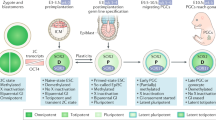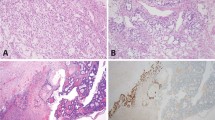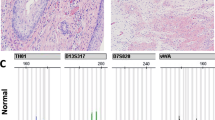Abstract
TERATOMAS are usually differentiated tumours, containing tissues derived from ectoderm, endoderm and mesoderm, and may arise in the gonads or elsewhere. Benign ovarian teratomas are parthenogenetic tumours derived from a single germ cell after the first division of meiosis, as studies of chromosome markers and enzyme variants have shown1,2. We have now found that extragonadal teratomas develop in a different manner. We have examined single gene products and chromosomes in extragonadal teratomas and report here our results. We include data on endodermal sinus tumours because of their similarity to teratomas3,4.
This is a preview of subscription content, access via your institution
Access options
Subscribe to this journal
Receive 51 print issues and online access
$199.00 per year
only $3.90 per issue
Buy this article
- Purchase on Springer Link
- Instant access to full article PDF
Prices may be subject to local taxes which are calculated during checkout
Similar content being viewed by others
References
Linder, D., and Power, J., Ann. Human. Genet., 34, 21 (1970).
Linder, D., McCaw, B. K., and Hecht, F., New Engl. J. Med., 292, 63 (1975).
Teilum, G., Acta path. microbiol. Scand., 64, 407 (1965).
Mostofi, F. K., and Price, E. B., Jr, Tumors of the male genital system (Armed Forces Institute of Pathology, Washington, DC, 1973).
Terasaki, P., Manual of tissue typing techniques (edit. by Ray, J. G., Scott, R. C., Hare, D. B., Harris, C. E., and Kayhoe, D. E.), 50 (National Institutes of Health, Bethesda, Maryland, 1972).
Laurent, M., Rousseau, M.-F., and Nezelof, C., Ann. d'Anatomic pathol., 13, 413 (1968).
Childs, B., Zinkham, W., Browne, E. A., Kimbro, E. L., and Torbert, J. V., Bull. Johns Hopkins Hosp., 102, 21 (1958).
Beutler, E., Yeh, M., and Fairbanks, V. F., Proc. natn. Acad. Sci. U.S.A., 48, 9 (1962).
Davidson, R. G., Nitowsky, H. M., and Childs, B., Proc. natn. Acad. Sci. U.S.A., 50, 481 (1963).
Epstein, C. J., Science, 163, 1078 (1969).
Linder, D., and Gartler, S. M., Science, 150, 67 (1965).
Beutler, E., Collins, Z., and Irwin, L. E., New Engl. J. Med., 276, 389 (1967).
Gartler, S. M., Ziprkowsky, L., Karkowski, A., Ezra, R., Szeinberg, A., and Adam, A., Am. J. hum. Genet., 18, 282 (1966).
Yoshida, A., Steinmann, L., and Harbert, P., Nature, 216, 275 (1967).
Gartler, S. M., Liskay, R. M., Campbell, B. K., Sparkes, R., and Gant, N., Cell Differentiation, 1, 215 (1972).
Author information
Authors and Affiliations
Rights and permissions
About this article
Cite this article
LINDER, D., HECHT, F., MCCAW, B. et al. Origin of extragonadal teratomas and endodermal sinus tumours. Nature 254, 597–598 (1975). https://doi.org/10.1038/254597a0
Received:
Published:
Issue Date:
DOI: https://doi.org/10.1038/254597a0
Comments
By submitting a comment you agree to abide by our Terms and Community Guidelines. If you find something abusive or that does not comply with our terms or guidelines please flag it as inappropriate.



